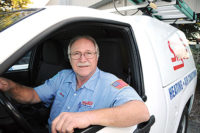So for the past four years, Lochinvar Corp. has been methodically and logically going about bringing all aspects of its water heater and boiler operation to a single location.
The end result is a 360,000-sq-ft facility here in Lebanon, about 30 miles east of downtown Nashville.
"We had a road map and long range plan," president Bill Vallett Jr. told members of the media during a tour of the new facility this summer. "We spent two years thinking about it before going into the planning stage. Then there was one year of planning and one year of construction."
The idea was not only to do it right for immediate needs, but to factor in future growth.
First of all, everything - manufacturing, engineering, R&D, the training lab, distribution center, and administrative offices - is all under one roof. The centerpiece of the new training center is an amphitheater-style auditorium with long worktables, a couple of electrical outlets per attendee, and modern audiovisual equipment.
The auditorium can seat up to 104 persons, although training classes are expected to be limited to 20 or 30 persons. A few steps from the auditorium is a hands-on training lab with a full range of equipment at multiple workstations. Initially, officials said the auditorium and training area - jointly dubbed "Lochinvar University" - may be used portions of 21 weeks a year, the majority of that time set aside for contractors. Information on contractor training is posted on the company's website at www.lochinvar.com.
Said Jeff Vallett, senior vice president for sales and marketing, "We have an obligation and the need to train and educate the industry. We may have the greatest technology in the world, but unless it is applied properly, installed properly, and maintained properly, people are going to become frustrated."

ON TOUR
There are 275 employees in the new building, including some 175 people at work on the manufacturing floor. The privately held company is non-union.Upstairs, executive offices share space with information systems, accounting, human resources, and sales and marketing.
Downstairs, a left turn from the entrance hall leads to the auditorium and training lab. A right turn leads to the customer service and technical service sector. Among the employees in that area are five service technicians who troubleshoot calls coming from the field to an 800 number. Those techs will also travel to jobsites if needed.
Down the hallway is the R & D lab and an additional lab to do life cycle testing at six stations.
The sheet metal department uses what Jeff Vallett called a "flexible manufacturing system with turret presses." The punched-out sheet metal is assigned to specific products coming down the assembly line at that time. "We only produce the steel that we need. Everything comes from the machine to the assembly line," Vallett said.
The assembly lines allow for what he called a "mixed model assembly," where production can be more closely geared to customer orders.
The operation employs what is called the "Quality At The Source Program." This system consists of 78 quality checks conducted throughout the manufacturing process. Vallett also noted that a representative from the American Society of Mechanical Engineers is at the plant during the 40-hour workweek to monitor the manufacturing process.
Jeff Vallett said the goal is to be able to deliver product within 24 hours.



